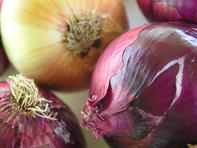
Scientific name: Allium cepa
Common Name: Onion
Onions have been used as food for centuries and are believed to have evolved in the arid regions of Western Asia.
Plant Description
Onions are an herbaceous biennial in the family Liliaceae grown for its edible bulb. The stem of the plant is a flattened disc at the base and the tubular leaves form a pseudo stem where their sheaths overlap. The leaves are either erect or oblique and there are between three and eight leaves per plant.Uses
Onions are cultivated for the use of the onion bulb. Mature and immature onions are eaten fresh or cooked and are to flavour food. They are also processed into pickles and soup and dried into onion flakes. The plants are sometimes used as a repellent for insects which attack other vegetables.Soil Requirements and Preparation
Onions grow well in sandy to clayey, well-drained soil. They prefer slightly acidic conditions with optimum pH requirements of between 5.5 and 6.5. The depth for soil preparation should be to 600mm.Climate
Onions are frost tolerant. They require cool conditions during the vegetative growth period followed by hot, dry conditions when nearing maturity in early summer.
Optimal temperatures for growth are 12°C to 24°C with monthly mean temperatures of between 7°C and 29°C Higher temperatures speed up bulb formation and lower temperatures will trigger flowering. Rainy spells in late spring and early summer reduce quality, particularly keeping quality.